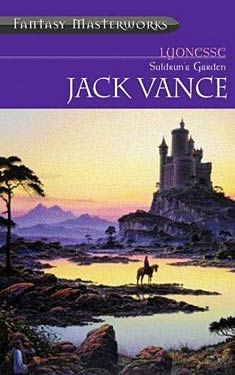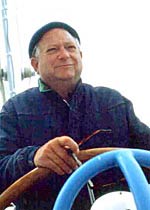GMRC Review: Suldrun’s Garden by Jack Vance
 Guest Blogger, Allie McCarn, reviews science fiction and fantasy books on her blog Tethyan Books. She has contributed many great book reviews to WWEnd and has generously volunteered to write some periodic reviews for our blog.
Guest Blogger, Allie McCarn, reviews science fiction and fantasy books on her blog Tethyan Books. She has contributed many great book reviews to WWEnd and has generously volunteered to write some periodic reviews for our blog.
 Lyonesse: Suldrun’s Garden by Jack Vance
Lyonesse: Suldrun’s Garden by Jack Vance
Published: Berkeley Publishing Group, 1983
Series: Book 1 of the Lyonesse Trilogy
Awards Nominated: Nebula Award, Locus Fantasy Award, and World Fantasy Award
The Book:
“The Elder Isles, located in the modern-day Bay of Biscay, contain a number of independent, often contentious, kingdoms. Some of kingdom’s monarchs have an eye towards unifying the entire region under a single rule. One of these ambitious rulers is King Casmir of Lyonesse, who is determined to use anyone and anything he can to conquer the other islands. For the most part, his ambition gains him only powerful enemies and war.
It is Casmir’s pretty, powerless, neglected daughter Suldrun, however, whose sad life sets a wide-reaching tale in motion Though most of the excitement and magic is experienced by others, the start of it all can be traced back to Suldrun’s peaceful, isolated garden. In these kingdoms full of violence, war, magic, ogres and fairies, there are plenty of adventures—good and bad—to be had by young princes, cruel rulers, and powerful sorcerers.” ~Allie
I know I said I was going to review The Sparrow next, but I wanted to make sure I got this month’s Grand Master Reading Challenge review out on time. This is the first novel I’ve read by Jack Vance, and it’s possible I should have started out with some of his science fiction. I’ve heard Vance’s work described as pulp-style adventure fare, where the destination of the story matters little compared to the interesting things you see along the journey.
My Thoughts:
Suldrun’s Garden starts out very much like what I would think of as a typical high fantasy. The Elder Isles seem like a fantasy version of medieval times, and the story seems constantly interrupted by lectures about lines of inheritance, politics, and geography. Whether all the dry detail is a benefit or a drawback will really depend on the reader. I can see the appeal of Vance portraying the Isles as a large place with many different peoples and lands. However, the solid blocks of information seemed to come at very jarring places in the narrative. In my case, it took me quite some time to develop an interest in the lands of the Elder Isles, and the information dumps were more of a hindrance than a help (at least initially) in building that interest.
The many characters that peopled the Elder Isles also seemed fairly usual for high fantasy–primarily princes and princesses, sorcerers, and fully evil villains. The story starts out featuring the pretty Princess Suldrun. She suffers from most of the familial problems of fantasy princesses (her father wants to marry her off, her parents really wanted a son, etc.). This is not necessarily always a formula for a boring character, but Suldrun is also incredibly passive and inactive. She spends most of her time wandering aimlessly about the castle and sitting alone in her garden. She does her best to avoid any kind of social interaction, so she has essentially no meaningful relationships. Of course, when her Hero shows up, she falls in love instantly and marries him shortly thereafter. The best thing I can say about Suldrun is that the novel soon abandons her to follow much more interesting stories.
The story of Suldrun’s Garden eventually builds to a climax, but it is difficult to see where it is going for most of the first half of the novel. The narrative skips from one character to another seemingly at random, though one can begin to see the design as the overarching story starts to become clear. Aside from Suldrun’s story, other plotlines feature the sorcerer Shimrod, the evil wannabe-sorcerer/ruler Carfilhiot, the wandering Prince Aillas, and the children Dhrun and Glyneth. It was with Shimrod’s story that I began to appreciate Jack Vance’s creativity, as he described magic and other realms. Prince Aillas’ journey is much more of a straightforward adventure story, with lots of hardship and daring deeds. The story of Dhrun and Glyneth, with its fairy-tale quality, is possibly my favorite. There are many different kinds of stories within this single novel, so it would be hard to not find something of interest. In my case, Suldrun’s story left me completely cold, but I thought that many of the other characters had delightfully creative, magical, and adventurous tales.
While I found a lot to enjoy in many of the stories, I was bothered by the frequent use of rape or the threat of rape in many of the plotlines. Of course, it’s not unreasonable that a story featuring a medieval-style society would include some depiction of rape. What most bothered me was the sheer prevalence of rape in this society and the way it was used in the story. It seemed like nearly every female character had been either raped or threatened with rape, sometimes more than once. One adolescent female character in particular, Glyneth, seemed to lead a life under the constant threat of rape. As far as the usage, rape typically seemed to be included as a comic story or as a way of showing the evilness of a villain. I did not appreciate the former, and the latter seemed entirely unnecessary. Most of the villains were clearly completely evil, and their actions, even without the rape, emphasized this ad nauseam.
 On more technical matters, the prose and dialogue were written in a stilted, formal, pseudo-medieval style. For an example, consider this description of furniture by Princess Suldrun, early in the story:
On more technical matters, the prose and dialogue were written in a stilted, formal, pseudo-medieval style. For an example, consider this description of furniture by Princess Suldrun, early in the story:
“Suldrun surveyed the interloping furniture with equal disapproval. It intruded into the space between the tall chairs, and impeded their intercourse. Why would anyone do so clumsy a deed? No doubt the arrival of the three grandees had dictated the arrangement.” P.38
All of the characters seemed to speak in a very similar manner, from a 9-year-old boy raised by fairies to the middle-aged king of a realm. For an example of the style of speech, here is a conversation that took place as King Casmir received visitors:
“’Sirs, for now I suggest that you make haste to your chambers, where warm fires and dry clothing will bring you comfort. In due course we will exchange our counsels.’
Sir Milliflor responded: ‘Thank you, King Casmir. In truth we are wet; the cursed rain has allowed us no respite!’ “ p.36
For the sake of comparison, here is the voice of a 9-year-old, considering his mortal peril:
Dhrun bethought himself of his talisman. “Remarkable that I am not terrified!” he told himself in a quavering voice. “Well, then, I must prove my mettle and kill these horrid creatures!” p.205
Since this is a novel with many, many characters, this sameness of voice sometimes made it difficult to keep the minor characters distinct in my mind. Altogether, there were certainly things to enjoy in Suldrun’s Garden, but I’m not sure this is a series I want to continue. I am considering checking out some of Vance’s science fiction, because I think his creativity might appeal to me more in a different style of world.
My Rating: 2.5/5
Suldrun’s Garden is a meandering tale, though the plotlines of the main characters do connect neatly in the climax and conclusion. The novel jumps from character to character, showing many kinds of stories—from the tale of the boring, anti-social Princess Suldrun, to those of wandering princes, sorcerers, evil rulers, and children caught in a kind of dark fairy tale. I very strongly disliked the prevalence and treatment of rape throughout the novel, and it did significantly reduce my enjoyment of the novel. The writing has a very stilted, pseudo-medieval feel, and the frequent asides about geography and cultures can be seen as either a strength or a weakness, depending on the reader’s preferences. Though much of the setting seems like generic fantasy fare, there are points where Vance’s creativity shines through. I will probably read more Vance in the future, but I’m not sure if I want to continue this trilogy.



















 Full Details
Full Details


4 Comments
FYI, that first sentence after the book description makes more sense in the context of my blog… I had listed Mary Doria Russell’s “The Sparrow” as the next review I would post, but I jumped ahead on my queue to write this one. 🙂
Thanks for the review. I’ve often been tempted by this series but never enough to pull the trigger. Sounds like I made the right choice. The Sparrow is one of my all-time favorites so I’m really looking forward to your review!
I concur with Dave. The Sparrow rates highly among my favorites.
I have the book in my e-library and have been meaning to read it for a while, even considering doing so for the GMRC. Judging by your concerns is seems that The Languages of Pao was the better choice. I would still want to read the Lyonesse trilogy, but it has now become a lesser priority.
From your experience with series, do you think the book has too much going on because it’s part of a trilogy? Or did Vance does try to incorporate too much? I get the idea that the characters might have run away with him. I might well enjoy the detailed world-building. This is probably Vance’s main strength, judging from others. I’ve only read Pao, so I shouldn’t really express any opinions until I’ve read a little more Vance.
@Dave: I loved The Sparrow, too. I hope my review will do it justice 🙂
@Emil: I read your review of “The Languages of Pao”, and I kind of regretted that I didn’t go with that one. The exploration of how language affects thought and vice versa sounded really interesting. In “Suldrun’s Garden”, the novel doesn’t always accurately reflect the importance of each character. For example, one character might seem rather important, and then never be mentioned again, while another might be mentioned casually in a single paragraph, only to suddenly become a main character hundreds of pages later. I do think he tries to incorporate a little too much of the world, though I suppose some of the things he discusses will likely be important later in the trilogy. Some of the world-building was really interesting, though, like the Ska culture (a highly organized culture of raiders), even if it was kind of a detour from the main plot. I think I really need to read some more Vance, too, since this is the only novel of his that I’ve read. I might go for “Languages of Pao” or “Dying Earth” next— the GMRC reviews of both of those looked neat!
Sorry, the comment form is closed at this time.